“If you google for an answer to how many outbound links you should be seeing on your pages, most answers fall into one of these categories:
- However many is most useful for users (okay, yeah, there’s truth there, but it’s not very useful, and everybody knows it’s not what you’re looking for)
- Less than 100, because ages ago that was the maximum Google could crawl (which is no longer true)
- None, ever, because you will bleed your PageRank or because Matt Cutts once said that outbound links can be a spam signal
- Link ALL the LINX!!!1!, because Matt Cutts once said that there are aspects of the algorithm that reward linking to good sites
- Some arbitrary figure pulled out of thin air
Well, I don’t like those answers. Neither does my boss, Corey Northcutt, who wants our rigorous audits, with their zillion-point checklists, to be based on hard data and fact-based opinions.
And so, to alleviate the problem, I conducted some original research. Here’s what I found.
Methodology
Before I share the results, let’s talk about where my data is coming from:
- I used this random word generator to generate an arbitrary but commonly used word. (I quickly realized when using a different tool that it was important for the word to be somewhat common, otherwise I was getting dictionary results, which would dramatically skew the kinds of pages I was looking at.)
- I then took the word to the Google Analytics Keyword Planner and sorted the keyphrase recommendations by least popular, and used the least popular query. Why? Because these are the most natural results. Popular search queries are competitive, so the top ranking pages are more likely influenced by SEO “best practices” and other marketing disciplines. I’m interested in learning about the algorithm here, not in what other marketers are doing. A study like this is still only looking at mere correlation, but where I can weed out noise from marketers, I will. (This is a major issue I have with other SEO correlation studies.)
- I ignored any queries that were related to videos, games, local, and any remaining queries that skewed toward dictionary results. I didn’t want the results tainted by influences from local algorithms, and since videos and games aren’t going to use many words, they’re of a completely different category when it comes to things like words per outbound link, and would serve as distracting outliers. Same again for the dictionary results.
- I used a private browser window (a new one for each query) to pull the top ten search results, ignoring any non-web results like images, knowledge graph, etc.
- I ran each of the pages through Screaming Frog and captured the word count, outlinks, and external outlinks
- I repeated this for a total of 20 queries, or 200 total search results.
- The histograms and scatterplot were made in Google Sheets (with the red bars highlighted in, yes, MS Paint)
- The ranges, interquartile ranges, medians, correlation, and statistical significance were found in Minitab 16.1.1 (I’ll elaborate on these, don’t worry.)
Now, the results
How Many Outbound Links Should You Use?
Let me cut to the chase by saying that if your average page is falling outside of these ranges, it’s worth asking yourself if your outbound linking strategy makes sense:
- All outbound links per page: 56 to 171
- All external outlinks per page: 5 (or 0) to 42 (More on this later.)
- Number of words per outlink: 6 to 23
- Number of words per external outlink: 29 to 232
- Also, a teaser: if you think external links are hurting your rankings, you might want to consider the possibility that the opposite is true.
Where did those numbers come from? Well, I looked at 200 search results: the top 10 for 20 “random” search queries. (“Random” here being defined above, in the Methodology section.) The middle 50% of those pages all fell within these ranges. Since these were all pages that made it to the top 10 search results, we know Google isn’t booting these pages out for falling in this range.
Now for a bit more depth. Let’s start by taking a look at all outbound links per page:
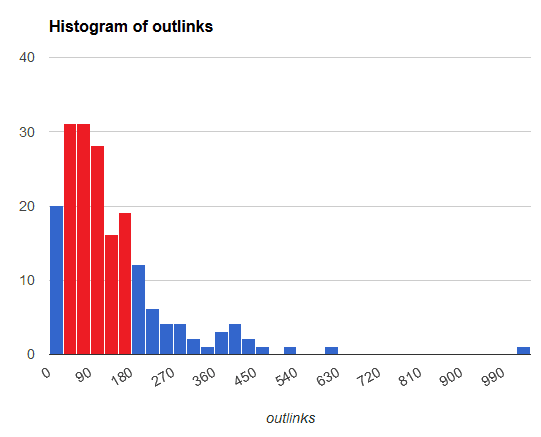
This is a histogram. Each bar represents a chunk of pages 30 outlinks wide. So the first bar counts all of the pages with 0 to 30 outlinks on them. The next bar counts all of the pages with 60 to 90 outlinks on them. And so on. As you can see, once you start to get out to about 450 outlinks, things are starting to look pretty lonely.
This contains the complete range of total outlinks I found for each of those pages. Not surprisingly, the minimum was 0 outlinks. The maximum was 1033. So, yes, you can make it to the front page of Google with 0 outlinks, and you can make it with 1033 outlinks. Good to know, but that still doesn’t tell us very much.
See that red section in the middle? That’s what statisticians like to call the “interquartile range.” It contains everything from the 25th percentile (called Q1) to the 75th percentile (called Q3).
The Q1-Q3 range is much narrower than the full range. It goes from 56 to 171. So, 50% of the pages that I looked at, relatively natural pages sitting on the front page of Google, had between 56 and 171 outlinks on them. The median, which separates the bottom half from the top half, was 101.
If you have fewer than 56 outlinks, or more than 171, you should probably ask yourself why. It’s not going to keep you from making it to the front page of Google. Like I said, everything here did. But if you’re outside of that center 50% range, you might want to ask yourself if it’s for good reasons.
Words Per Outlink
Since some pages have more words than others, relying strictly on the number of links per page isn’t necessarily a good idea. Another way to think about it is to focus on the number of words per link:
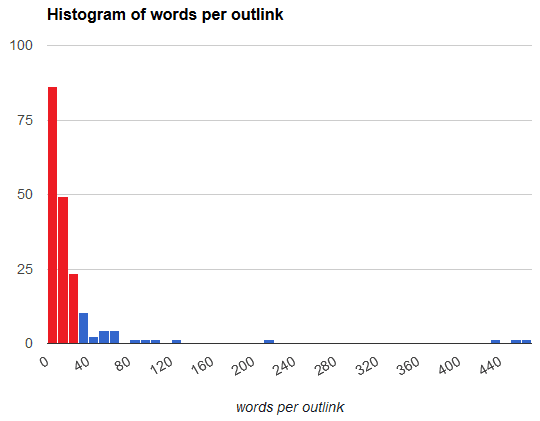
The total range goes from literally more links than words all the way up to all words and no links. More usefully, the Q1-Q3 range goes from 6.1 to 22.6 words per link. If you’re outside that range, you might want to ask yourself why. The median was 10.9.
The above is for all outbound links. What about outbound external links? You know, links that point to other sites?
External Outlinks
How did things look for external links?
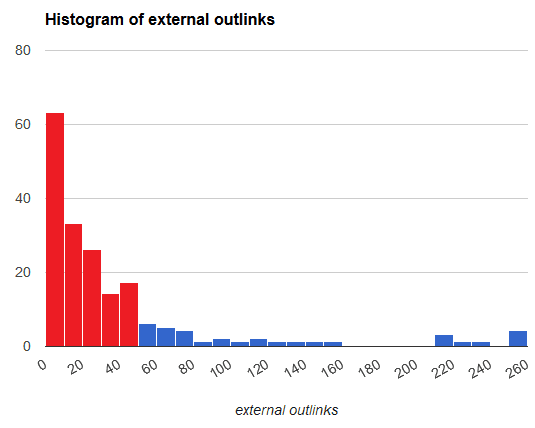
The total range for external outlinks per page was from 0 to 254. The Q1-Q3 range goes from 5 to 42. The median, dividing the top 50% and bottom 50%, was 19.
That’s considerably more external links than you might be expecting.
So, a caveat before we move on. Screaming frog looks at all “href” links, not just followed links. That means plugins, comment links, and so on, that point to external sites are getting counted here. However, it’s important to remember that, as far as PageRank is concerned, nofollowed links divide PageRank just like any other link.
Now, the question is, should you be concerned if you have less than 5 external links just because that puts you outside of the Q1-Q3 range? The answer is…maybe.
By no means should every page on your site have more than 5 external links. However, if your sitewide average is fewer than 5 external links per page, it’s worth asking why. Is it merely because you don’t use any plugins? Is it because your site consists entirely of landing pages with no blog style content? If so, it’s likely not an issue. In fact, external links on those kinds of pages could be considered a spam signal.
However, if your blog style content isn’t, on average, starting to approach at least 5 external links per page, you might deviate somewhat from what is natural, and what seems to be ranking well for natural queries.
Words Per External Outlink
Now let’s look at that from the perspective of words per external link:
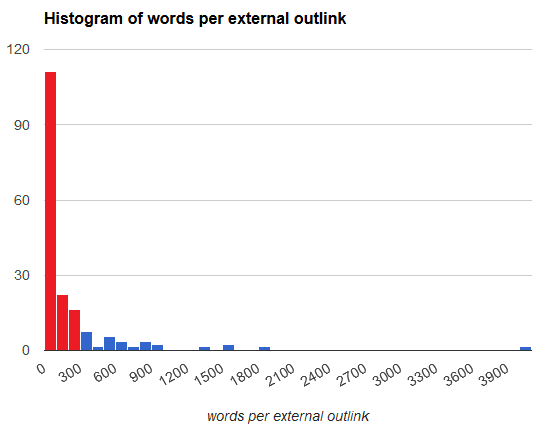
Incredibly, the minimum was 2.7 words per external link. The maximum was, of course, an entire document with no external links. The Q1-Q3 range went from 29.8 to 231.5 words per external outlink. So, another way of addressing the question above is to look at your pages and see if they go more than 230 words or so without an external link. Shorter pages don’t necessarily need any. Longer pages start to look a bit odd if they don’t have any external links.
Now, why am I concerning myself so much with the possibility of having too few external outlinks?
External Outlinks Per Page Is Showing A Statistically Significant Correlation With Rankings
My research found a positive correlation of 16.1% between rankings and external outlinks. That correlation was statistically significant (for you stats geeks, p=0.027).
Now, this is by no means a knock-it-out-of-the-park result. It’s statistically significant, but it’s still a small study, and yes, it’s correlation, not causation.
For the visually inclined, here’s what the relationship looks like:
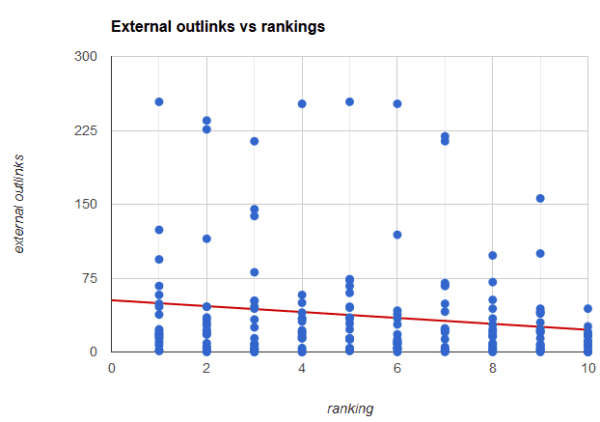
Now, I could make things look a lot cleaner by showing you a bar graph reporting the “average” number of external links for each ranking, but I want to prove a point here. Like all search engine relationships, this relationship is messy. Still, as you can see from that best-fit red line, the predicted number of external outlinks in position 1 is about 50, while the predicted number of external outlinks in position 10 is closer to 25.
Is this evidence that external outlinks can help your rankings?
On its own, not really. It could be because higher ranked pages get more comments, and therefore more external outlinks in the comment section. It could be because content producers who link out are doing a lot of other things that Google likes. It could be that more people reference these pages because they’re well sourced, which is why they have more external outlinks.
Of course, back in 2009, Matt Cutts said:
In the same way that Google trusts sites less when they link to spammy sites or bad neighborhoods, parts of our system encourage links to good sites.
So, does this mean everybody should start loading their pages with external outlinks?
It’s a possibility, but let’s not jump to that conclusion yet.
Instead, I plan to run a quasi-controlled experiment of my own to see what happens if I make some changes to one of my own sites.
Now I want to hear from you. Are these results surprising? How seriously do you think we should take the correlation between outbound externals and rankings?



